Biology - Gr.11 🦖 (UNIT 3: EVOLUTION) - Darwin's Evidence, Types of Selection, DNA/Mutations, Phylogenetic trees
1/28
Earn XP
Description and Tags
Darwin's 5 evidence + Malthus + Evolution of DNA, Types of Selection
Name | Mastery | Learn | Test | Matching | Spaced |
|---|
No study sessions yet.
29 Terms
What are 5 Darwin’s Evidence?
Fossil Records
Biogeography
Comperative Anatomy: Homologous structures
Comperative Anatomy: Embryology
Comperative Anatomy: Analogous structure
Fossil Records:
preserved remains within the earth
PROOF: simpler fossiles are generally found deeper, supporting Darwin’s concept that life was from simple to complex
ex. remains of giant sloths in South America to modern sloths
Biogeography
scientific study of geographic distribution of organisms based on both living species and fossils
PROOF: species in different areas evolve unique traits to adapt to their environments
ex. Darwin’s finches, different species on the Galapogos Islands
Comperative Anatomy: Homologous Structures
a structure w/ a common origin but serves different functions
PROOF: evidence for common ancestry
ex. forelimbs of bats (flying) vs humans (grasping)
Comperative Anatomy: Embryology
branch of biology that studies prenatal development of gametes
PROOF: embryos of different organisms share basic structures
ex. gill slits in early human development
Comperative Anatomy: Analogous structure
a sturcture w/ same function but different anatomical structure
PROOF: supports the idea of natural selection and the evolution of adaptations
ex. fins of sharks & dolphins
Malthus - The population:
population will out-pace available resources, leading to struggles for survival
PROOF: “positive checks”: famine, drought // “preventing checks”: contraceptions
ex. one child policy
Evolution fo DNA
changes that have occured in the structure and function in DNA over time, resulting in diveristy and complexity
ex. brown bear evolving to polar bear, result of beneficial mutations that allowed them to survive on arctic regions
What is sickle anemia?
→ a mutation in the hemoglobin protein. Having two copies of mutation creates “sickle cell anemia” (aa)
→ in some regions, having Aa is advantageous, creating resistance to Malaria
→ Those with AA, do NOT have the disease
What are the TWO types of selection?
Selective Pressure
Sexual Selection
What is Selective Pressure? (3 types)
→ depends on the environment
a. directional (ex. peppermoths)
b. stabilizing (ex. human birth weight)
c. disruptive (ex. rock pocket mice - due to location as a whole)
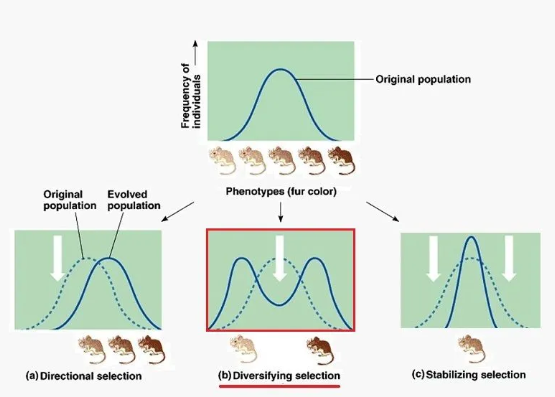
What is Sexual Selection? (2 types)
→ represented by changes in reproductive success “fitness” caused by sexual dimorphism (differences b/n woman and male)
Type #1: competition b/n males if the same species (ex. male deers w/ antler battles)
Type #2: Female choice (ex. peacocks w/ dances)
How to explain sexual selection?
→ a process where organisms that have certain traits have a greater chance of reproduction than others. This is due to mutations in the DNA that become advantageous mutations and make the organism favorable. These traits then get passed down.
Whtat are the FOUR types of mutations?
Substitution
Insertion
Deletion
“Frameshift”
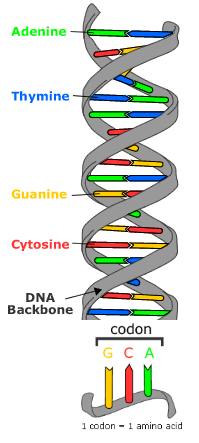
Substitution
→ Nitrogenous Base Pairs are deleted and swicthed out with a different base

Insertion
→ New nitrogenous base pairs are added (or inserted) to the strand of DNA

Deletion
→ Nitrogenous bases that are removed from the original strand of DNA

“Frameshift”
→ One nitrogenous base is deleted and is not replaced, thus modifying the order of instructions for amino acid production

What are the TWO causes of mutations at the DNA level?
Carcinogens
Errors during DNA replication (interphase - “s” phase)
Where are mutations located? (Hint: two places)
a) In the cells: somatic
→ occur in cells and do NOT form gametes, mutations that do NOT get carried by eggs or sperm
ex. mutations in skin, muscles or liver
b) In cells: Germ cells
→ occurs in reproductive cells and is eventually carried by gametes
ex. eggs & sperm
What are the THREE effects of mutations at the germ cell level?
No change: “does NOT occur in phenotype”
A little change: “DOES occur in phenotype”
A big change: “DOES occur in phenotype”
What are HOX genes?
→ determine the layout of body, determine where the head and appendages grow
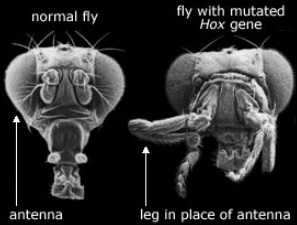
The changes (or mutations) are…
beneficial, harmful or neutral to an organism DOES NOT provide what an organism “needs”
→ Factors in the environment can influence the rate of mutation
ex. exposure to harmful chemicals may increase the mutation but will not make the organism resistant to the chemicals
What are phylogenetic trees?
→presents the relationships between living organisms. It shows who is close to whom.
→ which characteristics are the same in several species (inherited from a common ancestor)
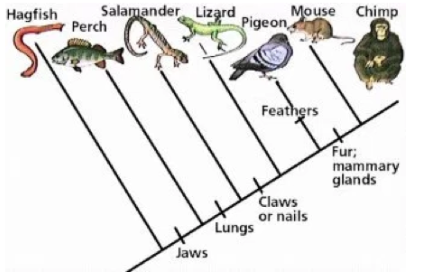
Clade
→ Grouping of several phyla of plants or animals having a common organization and origin.
The clade contains an ancestor and all its descendants.
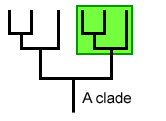
What is the anatomy of a chromosome?
Chromosome number
Regions (p or q)
Sub-regions
Bands
Why did two chimp chromosomes fused in humans?
1. Chromosome Fusion Event
→ Humans have 46 chromosomes, while chimpanzees have 48. Scientists discovered that human chromosome 2 is the result of a fusion of two smaller chromosomes that are separate in chimps. This fusion happened in a common ancestor of humans after the split from chimpanzees.
2. Evidence from Telomeres and Centromeres
→ In the middle of human chromosome 2, there are telomere sequences (normally found at the ends of chromosomes) and two centromeres, which is unusual. This is strong evidence that two chromosomes fused end-to-end, forming one larger chromosome in humans.
practice (phylogenetic trees)
header
—
—